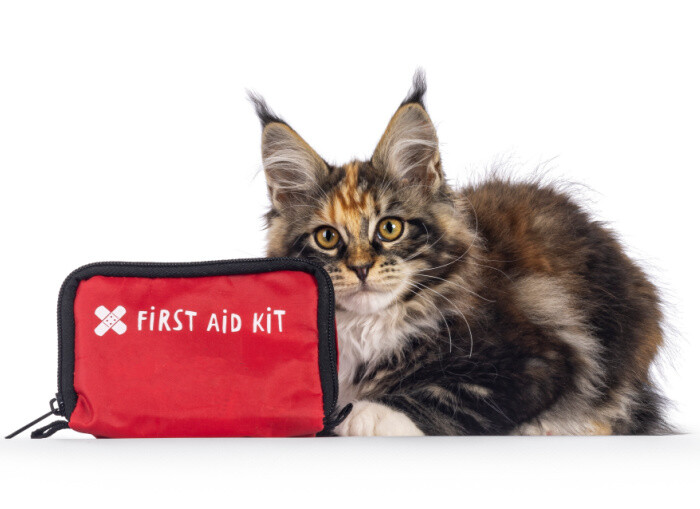Cats are curious creatures, often getting into mischief and occasionally finding themselves in need of medical attention. Whether it’s a minor scrape, a bee sting, or a more serious emergency, having a well-prepared first aid kit can make all the difference in providing timely care for your feline friend.
In this guide, we’ll walk you through the steps of creating your own cat first aid kit, ensuring you’re ready to handle any situation that may arise for your kitty!

Creating Your Own Cat First Aid Kit
Container: Start by selecting a sturdy, portable container to store your cat first aid supplies. A small plastic or metal box with a secure lid works well, keeping everything organized and easily accessible.
Basic Supplies:
-
- Gauze pads and rolls: Essential for cleaning and bandaging wounds.
- Adhesive tape: Secure gauze and dressings in place.
- Sterile saline solution: Use for flushing wounds or eyes.
- Antiseptic wipes or solution: To disinfect wounds and prevent infection.
- Scissors and tweezers: For cutting gauze, removing splinters, or trimming fur around wounds.

Wound Care:
-
-
- Triple antibiotic ointment: Apply to minor cuts and scrapes to promote healing.
- Cornstarch or styptic powder: Helps stop bleeding from minor cuts and nail trimming accidents.
-
Medications:
-
-
- Antihistamine (e.g., Benadryl): Useful for allergic reactions or insect stings. YOU MUST CONSULT your vet for proper dosage.
- Pet-friendly pain reliever: Have your vet recommend a suitable option and provide proper dosage instructions.
- Any prescribed medications: If your cat has specific health issues, include any prescribed medications in your kit.
 Additional Add-Ons for Your Cat First Aid Kit
Additional Add-Ons for Your Cat First Aid Kit
-
Emergency Supplies:
-
-
- Emergency contact numbers: Keep a list of important phone numbers, including your veterinarian, the nearest emergency veterinary clinic, and a poison control hotline.
- Emergency blanket: Use for warmth or to transport an injured cat.
- Muzzle or fabric strips: In case your cat becomes agitated or aggressive when injured.

-
Other Essentials:
-
-
- Disposable gloves: Protect yourself from potential contamination.
- Flashlight: Helpful for examining wounds or finding items in low light.
- Towel or blanket: Useful for restraining or comforting your cat during treatment.

-
Personalized Items:
-
-
- Medical records: Include a copy of your cat’s medical history, vaccination records, and any pertinent health information.
- Emergency evacuation plan: If you live in an area prone to natural disasters, include a plan for evacuating with your pets.
-
Regular Maintenance:
-
- Check expiration dates: Periodically review your first aid kit and replace any expired or used items.
- Practice using the kit: Familiarize yourself with the contents and how to use them, so you’re prepared in an emergency.

Creating a cat first aid kit is a proactive step towards ensuring your pet’s well-being in times of need. By assembling essential supplies and familiarizing yourself with their use, you can provide prompt and effective care for your feline companion.
Remember, while a first aid kit is essential, it’s no substitute for professional veterinary care. Always consult your veterinarian for guidance on treating injuries or illnesses, and keep your first aid kit stocked and ready for action. Your preparedness could make all the difference in your cat’s health and safety.
Leave a Reply